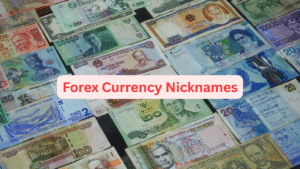 Forex Currency Nicknames Explained: A Complete Guide
Forex Currency Nicknames Explained: A Complete Guide
In the fast-paced world of forex trading, speed and clarity are everything. That’s why traders often use nicknames for currencies and currency pairs instead of their full names. These nicknames have evolved over time, influenced by culture, history, and even humor. Whether you’re a beginner or brushing up on your forex slang, this guide will walk you through the most commonly traded currencies and their nicknames—plus the fascinating stories behind them.
💱 Major Forex Currencies and Their Nicknames
These are the most heavily traded currencies, known as the “Majors,” and they form the backbone of the forex market.
1. US Dollar (USD) – “Greenback”
The U.S. dollar is called the “Greenback” due to the green color of U.S. paper money. It’s the world’s most traded currency and the base for many forex pairs.
2. Euro (EUR) – “Fiber”
The Euro got the nickname “Fiber” as a modern counterpart to the British “Cable.” It may also refer to the cotton-fiber paper used in euro banknotes.
3. British Pound Sterling (GBP) – “Cable”
One of the oldest nicknames in forex, “Cable” dates back to the 1800s when exchange rates between the U.K. and the U.S. were transmitted via undersea telegraph cables.
4. Japanese Yen (JPY) – “Yen” or “Ninja”
“Yen” is its official name, but traders sometimes call it “Ninja,” inspired by Japan’s cultural icons and the currency’s stealthy market moves.
5. Swiss Franc (CHF) – “Swissie”
A simple, affectionate term for the Swiss Franc. Known for its stability, it’s a popular safe-haven currency.
6. Canadian Dollar (CAD) – “Loonie”
Named after the loon bird depicted on Canada’s one-dollar coin, the Loonie is a major commodity currency influenced by oil prices.
7. Australian Dollar (AUD) – “Aussie”
Traders love the Aussie for its high interest rates and links to commodity exports like gold and iron ore.
8. New Zealand Dollar (NZD) – “Kiwi”
The Kiwi gets its name from New Zealand’s national bird, which also appears on some of its coins.
🌍 Minor and Commodity Currencies
These currencies are traded less frequently than the majors but still hold a vital place in global forex markets.
| Currency | Symbol | Nickname | Origin |
|---|---|---|---|
| Chinese Yuan | CNY | Redback | A nod to the “Greenback,” referencing the red hue of Chinese banknotes. |
| Singapore Dollar | SGD | Sing | Simply a short form of Singapore. |
| Hong Kong Dollar | HKD | Honkie | Slang derived from Hong Kong. |
| South African Rand | ZAR | Rand | Named after “Witwatersrand,” the ridge where gold was discovered. |
| Norwegian Krone | NOK | Nokie | Casual abbreviation. |
| Swedish Krona | SEK | Stockie or Stokkie | Referencing Stockholm. |
| Danish Krone | DKK | Dannie | Playful take on Denmark. |
| Mexican Peso | MXN | Mex | Slang for Mexico. |
| Brazilian Real | BRL | Real or Brazilian | Used informally. |
| Russian Ruble | RUB | Ruble | No strong nickname, usually just the name. |
| Turkish Lira | TRY | Lira | Used as-is in most trading contexts. |
🔄 Nicknames for Popular Forex Pairs
Not just currencies—currency pairs also come with nicknames. These often describe trading relationships, market behavior, or historical connections.
| Pair | Nickname | Notes |
|---|---|---|
| EUR/USD | Fiber | Most traded pair globally. |
| GBP/USD | Cable | Historic transatlantic connection. |
| USD/JPY | Gopher | A less common nickname, but still used. |
| USD/CHF | Swissie | From CHF (Swiss Franc). |
| AUD/USD | Aussie | Reflects Australia’s dollar. |
| NZD/USD | Kiwi | New Zealand’s bird and coin icon. |
| USD/CAD | Loonie | Based on Canadian dollar coin. |
| EUR/GBP | Chunnel | Named after the Channel Tunnel linking U.K. and EU. |
| GBP/JPY | Dragon | Known for wild market swings. |
| EUR/JPY | Yuppy | Mash-up of Euro and Yen. |
💡 Why Nicknames Matter in Forex
- Speed in Communication: Shorthand saves time during fast-paced trading.
- Cultural Identity: Many nicknames are deeply rooted in national identity or historical events.
- Market Jargon: Helps build camaraderie and shared language among traders.
Using nicknames correctly shows fluency in trader lingo and helps build trust in global trading environments.
❓FAQs About Forex Currency Nicknames
1. Why do traders use nicknames for currencies?
To speed up communication and add personality or shorthand to trades.
2. Is it essential to learn these nicknames?
While not mandatory, knowing them helps in understanding trader talk and market commentary.
3. Are these nicknames used globally?
Yes, especially among professional traders and in financial media.
4. Do all currencies have nicknames?
Not all, but most heavily traded ones do. Minor currencies may not have widely accepted nicknames.
5. Can I create my own nickname for a currency?
Yes. But unless it’s widely adopted, others may not recognize it. Stick to common ones for clarity.
🧾 Forex Currency Nicknames: Final Thoughts
Understanding forex currency nicknames is more than just fun trivia—it’s a practical part of becoming fluent in the language of trading. These nicknames help traders communicate clearly, quickly, and with a sense of history and humor that makes forex more accessible.
